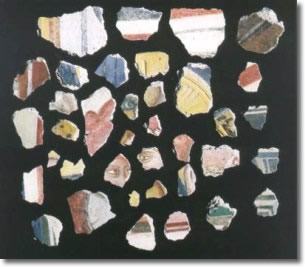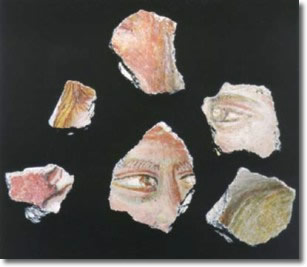
- Giotto's workshop, fragments of fresco decoration from the Palatine Chapel of the Castel Nuovo
Apart from the archeological finds of the classical period, the late medieval graveyards and the ceramic and metallic materials of the Angevin and Aragonese periods, the excavations of Sites 1, 2 and 3 of the Castel Nuovo have brought to light numerous gragments of painted plaster-work. Not all of the fragments appear to be of the same type and the same period; some of them seem to be part of a simple homogeneous coat of pale or dark paint, while others a rough geometrical decoration in yellow and rust-red on a white background.
Many of them, however, have the usual characteristics of a good brown coating, or thick plaster, with a red-earth preparatory design, or sinopite, of a thin, fine layer of plaster finish divided into "working days" - exactly as described by Cennino Cennini for 4th-century fresco technique - and finally a large range of colours, sometimes very elaborate - yellows, browns, reds, but also greens, light and lapislazzuli dark blues -of red cheeks, faces, heads, haloes and drapery, with much use of gilt and traces of decorative and architectural motifs; al of whicih is indicative of their coming from the same vat cycles of work by the same hand.
It is not only the technical characteristics, but also the content - the fragments of faces and clothes - that we recognize the formal characteristics of these frescoes which means that this "vast cycle" can only be what remains of the decoration of the Angevin castle commissioned by King Roberto and carried out between 1329 and 1333 by Giotto and his studio.
We know from the sources - from Petrarch on - and from documents of the time that between February 1329 and May 1331 Giotto frescoed a "secret chapel" of which we know nothing more, and again (above all) he did this with biblical and evangelical subjects. "In the Chapel of Castel Nuovo Giotto painted the Old and New Testaments over all the walls ...an excellent piece of work", in th opinion of the humanist Summonte (1524). This was the famous, still-standing Plantine Chapel; and later, perhaps, between 1331 and 1333, the whole of the Great Hall of the castle with a cycle of the nine famous men of antiquity and their companions, described in about 1350 in a sonnet-sequence and then by Ghiberti and other writers (leone de Castris 1986, Chapters V.1, 3)
Unfortunately, both of these undertakings were short-lived. The Great Hall cycle was definietly destroyed in the 50's of the 15th century by the total doing-up, in various and major dimensions, in various forms, of the hall itself, whicih from then on was covered by the great Gothic-Catalan umbrella-vault designed by Sagrera, and shortly afterwards christened the "Baron's Hall".
The other great cycle in the Palatine Chapel, most probably seriously damaged by the tragic earthquake of 1456 - as is shown by the huge cracks that once could be seen in the walls and the reinforcements and 15th-century fillings -and almost certainly replaced, at least in part, by the decoration commissioned and paid for in 1470-71 by Ferrante of Aragon and a certain Marchitello Gallo (Filangieri 1934; 1936-40; Leone de Castrisin Castel nuovo 1990).
